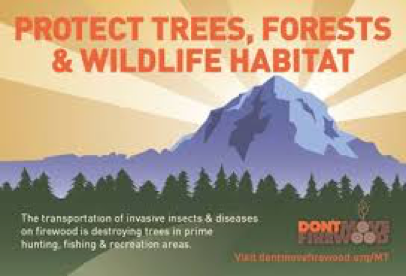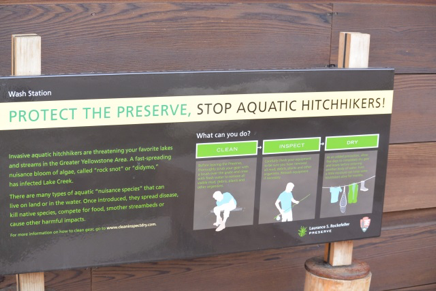News & Updates
Leave What You Find – Another side to the Leave No Trace Principle


Written by: Rob Stephens, Leave No Trace Arkansas State Advocate
What comes to mind when you think about the fourth Leave No Trace principle, Leave What You Find or, the Frontcountry version, Leave It as You Find It?
I suppose most of us think of not picking flowers, collecting fossils, defacing petroglyphs, cutting trees limbs, stacking cairns or damaging trees and rocks with graffiti. Indeed, if you ask any land manager what is the most frustrating visitor impact they encounter, it probably would be graffiti and carvings. We’ve all have seen those attempts at eternal love inscribed on rocks and park structures telling us that at one time Calvin©Kate or some forgettable person needed you to know they were there.
Although these are significant impacts, we often forget about one of the most costly impacts in our parks and public lands: invasive species. Leave What You Find can also mean leaving invasive plants and animals where they are, protecting our public lands from their costly impacts. A journal article by Pimental et al. (2005) reports that invasive species cost the United States more than $120 billion in damages annually. That cost is probably much higher today.
According to the USDA an "invasive species" is defined as a species that is:
1) a non-native (or alien) to the ecosystem under consideration and
2) whose introduction causes or is likely to cause economic or environmental harm or harm to human health.
This definition seems pretty straight forward, but it covers a broad range of harmful critters, diseases and pests. Just about anything we encounter daily: animals, aquatic species, microbes and plants could be invasive. Furthermore, these harmful invaders spread at astonishing rates. Their impacts are so great in the United States that an executive order was written to create The National Invasive Species Council (NISC). This council was established to ensure that Federal programs and activities to prevent and control invasive species are coordinated, effective and efficient. NISC members include the secretaries and administrators of 13 federal departments and agencies from the Department of Interior to NASA. Many of these are Leave No Trace Center for Outdoor Ethics Agency Partners.
I’ve always believed that the Leave No Trace Principles interact with one another in some way. Leave What You Find is particularly applicable to the fifth principle, Minimize Campfire Impacts. As a former Boy Scout leader, I’ve observed scout units hauling precut firewood to campgrounds. What they didn’t know was they were potentially moving pests and diseases from one ecosystem to another and also possibly violating the law. Our forests have acquired some very hair-raising pests and pathogens such as the Ash Borer, Beatles, Chestnut Gall Wasp, Sudden Oak Death and Dutch Elm disease. The problem is far reaching and the damage is great. Part of the solution is simple Don't Move Firewood. Buy firewood where you burn it or use existing fire wood at your campsite.

(Buy It Where You Burn It Poster)
Anglers interact with the environment by wading or boating in streams and lakes. This intimate contact with the water promotes them as potential carries of invasive species. Invasive species are a leading factor in freshwater fish extinctions and endangerments. In the greater Yellowstone area, there is an ongoing struggle with Rock Snot and algae that spreads easily through contaminated fishing gear, particularly waders. Rock Snot alters stream ecology by forming dense algal blooms that can suffocate a stream and the native fish. Click here to learn more about inspecting and cleaning your fishing gear. Boats should be emptied of water and live wells cleaned before traveling. Inspect the hull and engines and remove any barnacles or snails that might be attached.

(Laurance S. Rockefeller Preserve, Grand Teton NP)
For equestrians, the principal takes another turn. Horses eat hay and hay contains seeds. When stock animals and their hay are transported, these seeds also can take a ride in their digestive system. The use of weed free hay and straw is required by many National Forests and National Parks. Plan Ahead and Prepare by visiting their local websites to learn the current regulations and where to obtain weed free hay.
Bats in North America are now threatened by White Nose Syndrome, a disease affecting hibernating bats. Named for the white fungus that appears on the muzzle and other parts of hibernating bats, WNS is associated with extensive mortality of bats in eastern North America. It can be spread by spelunkers who travel from cave to cave. A multi-agency document is devoted to how to decontaminate clothing and gear after spelunking: National White-Nose Syndrome Decontamination Protocol
Hikers and campers should clean boots and gear thoroughly after use to prevent transporting seeds and contaminated soil to other areas. Empty out tents and stuff sacks and wash clothing used in the field. Plan Ahead and Prepare by learning the local regulations of the area you plan to visit before you travel. Just a few minutes of cleaning will help protect our public lands and help eliminate the spread of invasive species.
Let’s protect and enjoy our natural world together
Get the latest in Leave No Trace eNews in your inbox so you can stay informed and involved.
